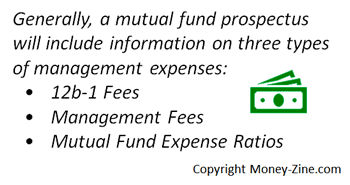In this final article in a four-part series dedicated to buying mutual funds, we'll be discussing both management fees and fund loads. We'll also discuss information about the fund's manager, which appears in the prospectus literature.
Managers of Mutual Funds
At one time, it was important for the mutual fund manager to have a great deal of prior experience in the stock market. This held true when mutual fund managers selected stocks based on a lot of "gut" feeling, and a little bit of analysis.
| Additional Resources |
| Buying Mutual Funds Part I Buying Mutual Funds Part II Buying Mutual Funds Part III Mutual Fund RatingMutual Fund ResearchMutual Fund Performance |
Computer programs make analyzing thousands of stocks over a short period of time a reality in today's marketplace. This means it's become less important for a manager to have a great deal of market experience, and there has been a growing emphasis on a manager's technical skills. Anyone interested in mutual funds should also be interested in knowing who is making the decisions where to invest their money. The prospectus for each fund will provide the name of the company supplying the fund manager, their name and start date, as well as a brief biography explaining their background. This includes where the manager has worked in the past, positions held in each company, and any accreditations they might hold such as a Chartered Financial Analyst.
Mutual Fund Management Fees
Given the responsibilities of the fund manager, or management team, it's only reasonable for them to charge fees for their services. Generally, a mutual fund prospectus will include information on three types of management expenses:
12b-1 Fees
Management Fees
Mutual Fund Expense Ratios
12b-1 Mutual Fund Fee
The 12b-1 fee represents the charges deducted from the mutual fund's assets to pay for marketing and contract distribution costs. If the fee structure has changed since the end of the most recent fiscal year, the 12b-1 fee is usually shown as a recalculation using the prior year's average asset base, along with the new fee structure. A fund's prospectus will also contain the maximum fees that can be charged in this area. It is up to the fund's management team to decide if they want to waive any of the associated contract distribution fees.
Management Fees

The management fee typically includes the administrative fees associated with running the mutual fund. Actual costs are those that were paid to management in the prior fiscal year. Once again, if the management fee structure changes, it will be restated using the new structure and the old asset base.
Expense Ratios
A mutual fund's expense ratio reveals the percentage of the fund's assets that were deducted to pay for all fund expenses. This includes 12b-1 fees, management fees, and all operating costs. Transaction fees, such as brokerage costs, are not included in the mutual fund expense ratio. The size of the expense ratio is typically related to the size, or asset base, of the mutual fund itself. Think of it this way. There are a lot of "fixed" costs associated with running a fund such as the manager's salary. If there are two fund managers with the same salary, and one manager is controlling twice as many assets as the other, then the expense ratio for that fund will be lower.
Mutual Fund Sales Fees or Loads
The second type of fee encountered when evaluating mutual funds is a sales fee, which is commonly referred to as a load. Once again, there are three types of mutual fund sales fees, or loads, which may appear in a fund's prospectus:
Front-End Loads, also known as Initial Sales Fees
Back-End Loads, also known as Deferred Sales Fees
Redemption Fees
Front-End Loads or Initial Sales Fees
A front-end load, or an initial sales fee, is a charge deducted from each investment in a mutual fund. The exact fee is usually stated as a percentage of the investment, and this percentage usually does not vary with the size of the investment. However, some mutual funds will reduce the fee for larger investments, or as the total size of an individual's portfolio grows.
Front-Load Example
Let's say a mutual fund charges a 2.0% front-load for investments under $25,000, and 1.0% for investments in excess of $25,000. In this example, a $20,000 investment would pay 2.0% of 20,000, or $400 in fees. An investment of $30,000 would pay 2.0% of the first $25,000, or $500, plus 1.0% of the next $5,000, or $50, for a total front-load fee of $550.
Back-End Loads or Deferred Sales Fees
The second type of mutual fund sales fee encountered is a back-end load, or a deferred sales fee. A back-end load is a charge that is applied when shares in a mutual fund are sold. This type of fee structure is sometimes used to discourage active trading in a mutual fund.
Back-End Load Example
For example, a mutual fund might charge a 4.0% back-end load if the investor sells their shares during the first year of ownership. In subsequent years, the back-end load might slowly decrease, until the point where no fee is owed on the sale.
Redemption Fees
The final mutual fund fee an investor might encounter is called a redemption fee. Just like the back-end load, a redemption fee is often used to discourage active trading in a mutual fund, and it is charged when shares in the fund are sold. Unlike a back-end load, redemption fees are typically applied only during the first year of ownership. When a redemption fee is charged, the money is returned to the fund itself, not to the managers of the fund. This means redemption fees are not shown as a cost to other shareholders. Redemption fees are usually calculated based on the ending share value; whether the fund's value has appreciated or depreciated over time.
About the Author - Mutual Funds: Management Fees and Loads



.jpg)
.jpg)